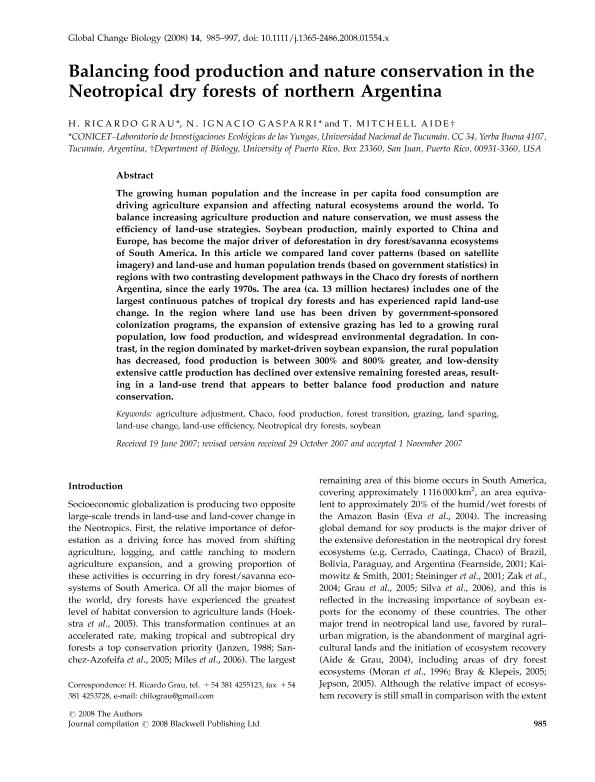Artículo
Balancing food production and nature conservation in the Neotropical dry forests of northern Argentina
Fecha de publicación:
12/2008
Editorial:
Wiley Blackwell Publishing, Inc
Revista:
Global Change Biology
ISSN:
1354-1013
Idioma:
Inglés
Tipo de recurso:
Artículo publicado
Clasificación temática:
Resumen
The growing human population and the increase in per capita food consumption are driving agriculture expansion and affecting natural ecosystems around the world. To balance increasing agriculture production and nature conservation, we must assess the efficiency of land‐use strategies. Soybean production, mainly exported to China and Europe, has become the major driver of deforestation in dry forest/savanna ecosystems of South America. In this article we compared land cover patterns (based on satellite imagery) and land‐use and human population trends (based on government statistics) in regions with two contrasting development pathways in the Chaco dry forests of northern Argentina, since the early 1970s. The area (ca. 13 million hectares) includes one of the largest continuous patches of tropical dry forests and has experienced rapid land‐use change. In the region where land use has been driven by government‐sponsored colonization programs, the expansion of extensive grazing has led to a growing rural population, low food production, and widespread environmental degradation. In contrast, in the region dominated by market‐driven soybean expansion, the rural population has decreased, food production is between 300% and 800% greater, and low‐density extensive cattle production has declined over extensive remaining forested areas, resulting in a land‐use trend that appears to better balance food production and nature conservation.
Palabras clave:
Agriculture Adjustment
,
Deforestation
,
Forest Transition
,
Soya
Archivos asociados
Licencia
Identificadores
Colecciones
Articulos(CCT - NOA SUR)
Articulos de CTRO.CIENTIFICO TECNOL.CONICET - NOA SUR
Articulos de CTRO.CIENTIFICO TECNOL.CONICET - NOA SUR
Citación
Grau, Hector Ricardo; Gasparri, Nestor Ignacio; Aide, Michelle T.; Balancing food production and nature conservation in the Neotropical dry forests of northern Argentina; Wiley Blackwell Publishing, Inc; Global Change Biology; 14; 5; 12-2008; 985-997
Compartir
Altmétricas




